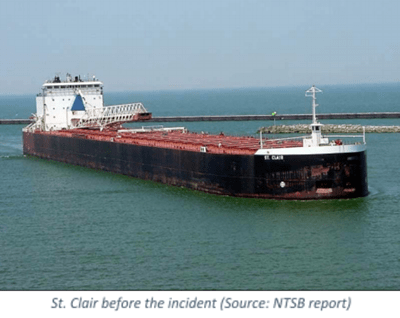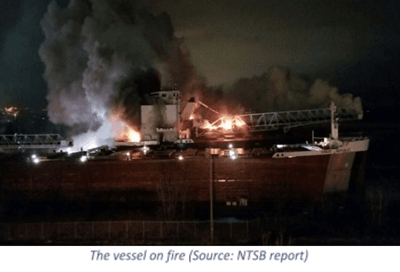Engine Room Fire Onboard a Laid-up Bulk Carrier
Further to our article, Ship Lay up During the Coronavirus Pandemic, we are providing an investigation report from The National Safety Board (NTSB) to highlight the importance of proper preparation and elaborate procedures before and during lay-up. This report concerns a fire incident on board of a laid-up vessel and should be of interest to members who already have taken vessels out of operation or are considering lay-up arrangements.

As per NTSB Accident Report summary:
‘About 2010 local time on February 16, 2019, a fire was reported on the bulk carrier St. Clair while the vessel was laid-up for the winter at the CSX TORCO Iron Ore Terminal (TORCO dock) at the mouth of the Maumee River in Toledo, Ohio. No one was on board. The fire was extinguished approximately 36 hours later by shoreside firefighters. No pollution or injuries were reported. The estimated property damage exceeded $150 million.’
Fire damage extended to the engine room, the entire superstructure, the unloading belt throughout the conveyor tunnels to the bow, as well as to the cargo conveyor boom belt above the main deck.

After the fire was extinguished, the engine room was found flooded through the strainers and sea chests, which were kept open during the layup. The sea valve was electrically controlled and designed to open in case of an electrical blackout. During the fire, the vessel lost the shore power, the valve opened and water was able to ingress into the engine room through disassembled pipework sections. Had the probability of a loss of power been prepared for, the damages from such circumstances may have been mitigated through appropriate actions beforehand.
The probable cause of fire on board is determined to have been:
‘the ignition of combustible material in the vicinity of an engine room workshop likely due to the use of portable space heaters or smoldering smoking materials, which spread to other areas of the vessel. Contributing to the extent of the fire damage was the lack of operating procedures for continuous active monitoring of the vessel while in layup status.’
The finding of the report emphasises the need to clearly identify potential hazards onboard and have mitigation protocols in place when preparing to lay-up a vessel. The full report can be found here National Transportation Safety Board: Marine Accident Brief.
